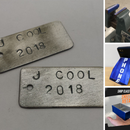Introduction: Sheet Metal Vise Jaw Covers
Introduction
These vise jaw covers are quick and easy to make. They also provide a very low risk, useful project to try while learning how to work with sheet metal. This is the second shop activity I have my level 1 students make, which allows me to introduce and demonstrate using our sheet metal break and aviation snips. These little covers are great to have whenever you are working around the shop as you can take them on and off your vise as needed. Without these covers when we use our vises on class projects we end up with marks all over our work.
This project can be entirely made by using non powered hand tools and equipment.
If you're just getting started with working with sheet metal check out my other sheet metal Instructable on how to make SHEET METAL DOG TAGS.
Step 1: Video Tutorial
If you like watching more than reading watch the tutorial video I mostly put together for my students to learn from. This version has a few more frills than the rather blank version my students got to watch.
Step 2: Tools and Materials List
Materials List
- Sheet Metal (I used 22 gauge)
- Layout Fluid (optional)
- Clear Coat Spray Paint (optional)
Tools and Equipment List
- Scratch Awl
- Ruler
- Aviation Snips
- Sheet Metal Break
- File (optional)
- Sand Paper (Optional)
Step 3: Planning
Before we can make covers for the jaws of our vise, we need to know how big the jaws are. I have my students use a ruler to take the measurements of the vises in our shop and then create a drawing for their layout. I've included the drawing I use as an example in my class if you would like to use it.
I have my students punch their name and class period into the top of their covers so that they can leave them in the classroom and use them throughout the year. I'm not showing the punching step in this Instructable but if you would like to know how to imprint something onto your covers you can see that process in my Sheet Metal Dog Tag Instrucatable.
The order of operations for this step are as follows:
1) Measure and record the width, height and depth of the vise jaws. 


2) Create a layout drawing using those measurements.
Attachments
Step 4: Measure and Snip to Size
Once you have your measurements and plans its time to cut your metal to size. I always have a bunch of strips of scrap metal from cutting up blanks for different class projects. The strip I am using for this Instructable was already at 1 1/4 inch in height, so all I needed to do was cut two, four inch pieces from it. These strips will turn into the covers.
I have sprayed my metal with blue layout fluid to make it easier to see my marks in the pictures. For simple work like this layout fluid is not really needed as you will be able to see your scratch marks on your metal without it. I do not have my students use metal sprayed with layout fluid but if you would like to use some go right ahead. You should be able to find layout fluid at any of your local hardware stores.
The order of operations for this step are as follows:
1) Cut your metal to the needed height
2) Measure out the length needed to cover one vise jaw and then repeat so you have marks to make two covers.
3) Cut metal to length with aviation snips.

You should end up with something like these.

Step 5: Layout
I want covers that will sit on top of our vise jaws and not fall off or have a large amount of excess material hanging over the sides or off the bottom of the jaw. Use your measurements for the depth and height of the vise jaw to mark your bend line on your metal that has been cut to length. For our shop that measurement was 1/2 inch.
The order of operations for this step are as follows:
1) Measure and mark the distance for your bend line. Give yourself two marks if your only using a ruler to help mark your line. This will help keep your line nice and straight

2) Use your ruler as a straight edge in combination with your scratch awl to mark your bend line onto your metal.

3) Repeat the steps 1 and 2 for your other piece of metal.

Step 6: File (optional Step)
I have my students round off the sharp corners of the metal using a file. This isn't necessary but more often than not my students are a little clumsy and the less sharp corners they have to cut themselves on the better.
The order of operations for this step are as follows
1) Clamp your metal into the vise with a corner slightly sticking out. (Since we are making are covers for the jaws and they will be getting marks on them anyway don't worry about how hard you clamp down with your vise)
2) Run your file across your metal at a slight angle away from you.

3) Continue to run your file across your metal working the sharp corner into a nice rounded corner.

4) Repeat steps 1-3 as necessary until all your corners are nicely rounded.

Step 7: Bend
With your metal cut to size and line marked for bending its time to move over to the brake. Our goal is to bend each one of our covers to roughly 90 degrees. The most important part of this step is to make sure you clamp the teeth of your break right on your line. Even if you just get your metal lined up with a very small angle it will make your fold look completely off.
The order of operations for this step are as follows:
1) Use your clamping bar handle to lift up the teeth of your brake.
2) Slide your metal piece underneath the teeth and line your marked line up with the edge of the teeth.
3) Lower the clamping bar handle down to clamp your metal into place.

4) Use your bending leaf handles to slowly fold your metal to 90 degrees

5) Return you bending leaf to neutral position and lift up your teeth to remove your bent metal. Your piece should look similar to the image below.

6) Repeat steps 1-5 for your other metal piece.
Step 8: Finished!
From this: 
To this: 
Now you can use the full strength of your vise without fear of leaving marks all over your project. This is a great quick little project that I use to teach my students how to use a couple of new tools in our shop. Also with our newly formed covers we can use our vises for new operations like helping to bend our metal or flatten metal out to make better hems without having to use a hammer.

If you feel the need to you can coat these sheet metal covers in some paint or clear coat so they wont rust. Just be sure if you do paint them, that you use sandpaper or some other abrasive to clean up and prepare your metal before painting.
If you end up making yourself a set let me know!
Enjoy creating and learning!
Step 9: The End Bit
Thank you so much for checking out my project. I truly appreciate people taking time to view my work. If you were looking to build a little amp I hope this was helpful to you in some way or at the very least somewhat interesting.
If you teach shop class of some kind I've started a little website to document/compile shop teacher content/curriculum. I'm really just getting started with it but I should be posting much more to it soon. Find it at Shop Class Builds.
Find me on Instagram @shopclassbuilds
Again thank you for taking time out of your day to scan through my project! Let me know in the comments if you make one or something similar!







